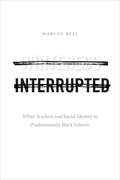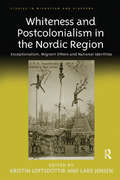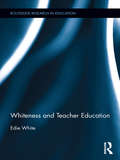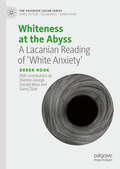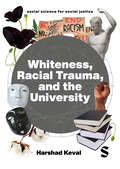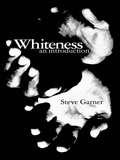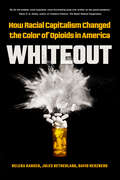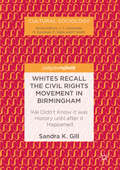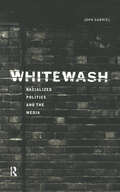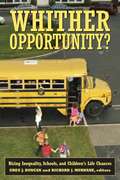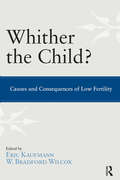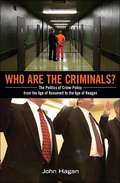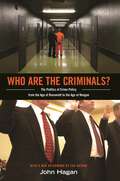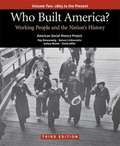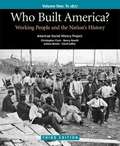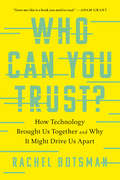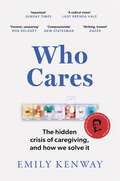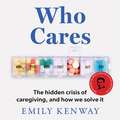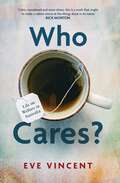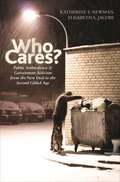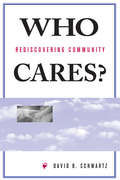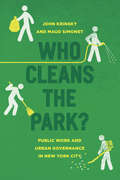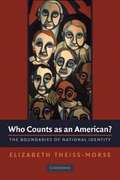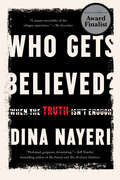- Table View
- List View
Whiteness Interrupted: White Teachers and Racial Identity in Predominantly Black Schools
by Marcus BellIn Whiteness Interrupted Marcus Bell presents a revealing portrait of white teachers in majority-black schools in which he examines the limitations of understandings of how white racial identity is formed. Through in-depth interviews with dozens of white teachers from a racially segregated, urban school district in Upstate New York, Bell outlines how whiteness is constructed based on localized interactions and takes a different form in predominantly black spaces. He finds that in response to racial stress in a difficult teaching environment, white teachers conceptualized whiteness as a stigmatized category predicated on white victimization. When discussing race outside majority-black spaces, Bell's subjects characterized American society as postracial, in which race seldom affects outcomes. Conversely, in discussing their experiences within predominantly black spaces, they rejected the idea of white privilege, often angrily, and instead focused on what they saw as the racial privilege of blackness. Throughout, Bell underscores the significance of white victimization narratives in black spaces and their repercussions as the United States becomes a majority-minority society.
Whiteness and Postcolonialism in the Nordic Region: Exceptionalism, Migrant Others and National Identities (Studies in Migration and Diaspora)
by Lars Jensen Kristín LoftsdóttirThis book examines the influence of imperialism and colonialism on the formation of national identities in the Nordic countries, exploring the manner in which contemporary discourses in Nordic society are rendered meaningful or obscured by references to past events and tropes related to the practices and ideologies of colonialism. Against the background of Nordic 'exceptionalism', it explores the manner in which the interwoven racial, gendered and nationalistic ideologies associated with the colonial project form part of contemporary Nordic identities. An important challenge to national identities that can become increasingly inward looking, Whiteness and Postcolonialism in the Nordic Region sheds light on the ways in which certain notions and structural inequalities, understood as residue from the colonial period, become recreated or projected onto different groups. Presenting a variety of case studies drawn from Sweden, Finland, Norway, Greenland, Denmark and Iceland, this book will be of interest to scholars across the social sciences and humanities conducting research in the fields of race and ethnicity, identity and belonging, media representations of 'the other' and colonialism and postcolonialism.
Whiteness and Teacher Education (Routledge Research in Education)
by Edie WhiteDue to the rise of internet use and a move toward globalization, it may be assumed that white millennial college students are more accepting of cultural diversity and are more likely to be advocates for social justice than generations that have come before them. This project shows that while many white students know how to speak the language of "correctness" and to some degree even believe in what they are saying, their limited personal experiences with those who are racially different from themselves often bump against their beliefs about racial acceptance and equality. This project investigates the ways that one facet of identity, whiteness, influences teachers’ understanding of their roles in the schools and informs their decision making within their practice. It explores several life stories of five teacher candidates, all born after 1985. Through these stories we get a sense of how white prospective teachers imagine themselves as teachers of diverse students and how they imagine developing equitable practices. This work advocates that teacher educators help pre-service teachers unpack and understand their biases in order to facilitate their students in balancing their life experiences with whom they imagine themselves to be as teachers.
Whiteness at the Abyss: A Lacanian Reading of ‘White Anxiety’ (The Palgrave Lacan Series)
by Derek Hook&‘Whiteness&’ is an omnipresent term within research on race and racism. This book differs from existing conceptualizations by adopting a psychoanalytic line of approach and by directing its attention to a particular socio-historical instantiation of whiteness—the investments, fantasies and fears apparent within (post) apartheid South African contexts. It foregrounds the notion of &‘white anxiety&’, which is conceptualized not only via notions of psychical temporality, but with reference to the dystopian visions of the future, ideas of inter-generational guilt, and fantasies of demise. To posit an imagined &‘end to whiteness&’ is not, of course, an uncontroversial gesture; the closing section of the book surveys the key themes—antisemitism, white Nationalism, the trope of the race traitor—in online attacks the author was subjected to. This compelling work will appeal to all those with an interest in psychoanalytic approaches to race and racism, and to anyone working in the areas of critical race and whiteness studies.
Whiteness, Racial Trauma, and the University: Experiencing Whiteness in the University (Social Science for Social Justice)
by Harshad KevalUniversities are regarded as safe havens for knowledge production and the educational transformation of lives. There is, however, a long history of universities as sites of contestation where structures of hierarchical legitimacy are played out. In response to the upsurge in global protests against racial violence and the criticism of colonial, racialised and Eurocentric forms of thinking, universities have adopted new roles as ‘anti-racist’ and ‘decolonial’ beacons of hope. This book unravels how such liberal progressive ‘acts’ hide a much deeper racialised logic of whiteness-framed structural narcissism, producing insidiously powerful and difficult to trace forms of racialised harm. The Social Science for Social Justice series challenges the Ivory Tower of academia, providing a platform for academics, journalists, and activists of color to respond to pressing social issues.
Whiteness, Racial Trauma, and the University: Experiencing Whiteness in the University (Social Science for Social Justice)
by Harshad KevalUniversities are regarded as safe havens for knowledge production and the educational transformation of lives. There is, however, a long history of universities as sites of contestation where structures of hierarchical legitimacy are played out. In response to the upsurge in global protests against racial violence and the criticism of colonial, racialised and Eurocentric forms of thinking, universities have adopted new roles as ‘anti-racist’ and ‘decolonial’ beacons of hope. This book unravels how such liberal progressive ‘acts’ hide a much deeper racialised logic of whiteness-framed structural narcissism, producing insidiously powerful and difficult to trace forms of racialised harm. The Social Science for Social Justice series challenges the Ivory Tower of academia, providing a platform for academics, journalists, and activists of color to respond to pressing social issues.
Whiteness: An Introduction
by Steve GarnerWhat is whiteness? Why is it worth using as a tool in the social sciences? Making sociological sense of the idea of whiteness, this book skilfully argues how this concept can help us understand contemporary societies. If one of sociology's objectives is to make the familiar unfamiliar in order to gain heightened understanding, then whiteness offers a perfect opportunity to do so. Leaning firstly on the North American corpus, this key book critically engages with writings on the formation of white identities in Britain, Ireland and the Americas, using multidisciplinary sources. Empirical work done in the UK, including the author's own, is developed in order to suggest how whiteness functions in Britain. Bringing an emphasis on empirical work to a heavily theorized area, this important text synthesizes and reviews existing work, incorporates multidisciplinary sources of interest to those outside the sociology sphere, and features concise chapters which will engage undergraduates. Garner deftly argues that whiteness is a multifaceted, contingent and fluid identity, and that it must be incorporated into any contemporary understandings of racism as a system of power relationships in both its local and global forms.
Whiteout: How Racial Capitalism Changed the Color of Opioids in America
by David Herzberg Helena Hansen Jules NetherlandThe first critical analysis of how Whiteness drove the opioid crisis. In the past two decades, media images of the surprisingly white "new face" of the US opioid crisis abounded. But why was the crisis so white? Some argued that skyrocketing overdoses were "deaths of despair" signaling deeper socioeconomic anguish in white communities. Whiteout makes the counterintuitive case that the opioid crisis was the product of white racial privilege as well as despair. Anchored by interviews, data, and riveting firsthand narratives from three leading experts—an addiction psychiatrist, a policy advocate, and a drug historian—Whiteout reveals how a century of structural racism in drug policy, and in profit-oriented medical industries led to mass white overdose deaths. The authors implicate racially segregated health care systems, the racial assumptions of addiction scientists, and relaxed regulation of pharmaceutical marketing to white consumers. Whiteout is an unflinching account of how racial capitalism is toxic for all Americans.
Whites Recall the Civil Rights Movement in Birmingham: We Didn’t Know it was History until after it Happened (Cultural Sociology)
by Sandra K. GillThis illuminating volume examines how the 1963 bombing of the Sixteenth Street Baptist Church in Birmingham, Alabama developed as a trauma of culture. Throughout the book, Gill asks why the “four little girls” killed in the bombing became part of the nation’s collective memory, while two black boys killed by whites on the same day were all but forgotten. Conducting interviews with classmates who attended a white school a few blocks from some of the most memorable events of the Civil Rights Movement, Gill discovers that the bombing of the church is central to interviewees’ memories. Even the boy killed by Gill’s own classmates often escapes recollection. She then considers these findings within the framework of the reception of memory and analyzes how white southerners reconstruct a difficult past.
Whitewash: Racialized Politics and the Media
by John GabrielBy putting the language used in television, the radio, the internet and press, as well as that spoken by key leaders, under the spotlight, what is ultimately revealed is the existence of a 'white' language, both coded and overt. Taking specific examples and presenting new factual evidence, John Gabriel studies the racial politics that lie behind much of the communication in the public arena. Case studies draw on contemporary political controversies and are used to explore the relationship between racialised forms of media discourse and political and economic change.
Whither Opportunity?: Rising Inequality, Schools, and Children's Life Chances
by Richard J. Murnane Greg J. DuncanAs the incomes of affluent and poor families have diverged over the past three decades, so too has the educational performance of their children. But how exactly do the forces of rising inequality affect the educational attainment and life chances of low-income children? In Whither Opportunity? a distinguished team of economists, sociologists, and experts in social and education policy examines the corrosive effects of unequal family resources, disadvantaged neighborhoods, insecure labor markets, and worsening school conditions on K-12 education. This groundbreaking book illuminates the ways rising inequality is undermining one of the most important goals of public education—the ability of schools to provide children with an equal chance at academic and economic success. The most ambitious study of educational inequality to date, Whither Opportunity? analyzes how social and economic conditions surrounding schools affect school performance and children’s educational achievement. The book shows that from earliest childhood, parental investments in children’s learning affect reading, math, and other attainments later in life. Contributor Meredith Phillip finds that between birth and age six, wealthier children will have spent as many as 1,300 more hours than poor children on child enrichment activities such as music lessons, travel, and summer camp. Greg Duncan, George Farkas, and Katherine Magnuson demonstrate that a child from a poor family is two to four times as likely as a child from an affluent family to have classmates with low skills and behavior problems – attributes which have a negative effect on the learning of their fellow students. As a result of such disparities, contributor Sean Reardon finds that the gap between rich and poor children’s math and reading achievement scores is now much larger than it was fifty years ago. And such income-based gaps persist across the school years, as Martha Bailey and Sue Dynarski document in their chapter on the growing income-based gap in college completion. Whither Opportunity? also reveals the profound impact of environmental factors on children’s educational progress and schools’ functioning. Elizabeth Ananat, Anna Gassman-Pines, and Christina Gibson-Davis show that local job losses such as those caused by plant closings can lower the test scores of students with low socioeconomic status, even students whose parents have not lost their jobs. They find that community-wide stress is most likely the culprit. Analyzing the math achievement of elementary school children, Stephen Raudenbush, Marshall Jean, and Emily Art find that students learn less if they attend schools with high student turnover during the school year – a common occurrence in poor schools. And David Kirk and Robert Sampson show that teacher commitment, parental involvement, and student achievement in schools in high-crime neighborhoods all tend to be low. For generations of Americans, public education provided the springboard to upward mobility. This pioneering volume casts a stark light on the ways rising inequality may now be compromising schools’ functioning, and with it the promise of equal opportunity in America.
Whither the Child?: Causes and Consequences of Low Fertility
by W. Bradford Wilcox Eric P. KaufmannBirth rates are falling and fertility rates are well below replacement levels. At the same time, the economic crisis has forced governments to scale back public spending, reduce child support, and raise the retirement age, causing immense social conflict. Taking a step outside the disciplinary comfort zone, Whither the Child? asks how demography affects individuals and society. What does it feel like to live in a low fertility world? What are the consequences? Is there even a problem - economically, culturally and morally? No other book confronts so many dimensions of the low fertility issue and none engage with the thorny issues of child psychology, parenting, family, and social policy that are tackled head-on here.
Who Are the Criminals? The Politics of Crime Policy
by John HaganHow did the United States go from being a country that tries to rehabilitate street criminals and prevent white-collar crime to one that harshly punishes common lawbreakers while at the same time encouraging corporate crime through a massive deregulation of business? Why do street criminals get stiff prison sentences, a practice that has led to the disaster of mass incarceration, while white-collar criminals, who arguably harm more people, get slaps on the wrist--if they are prosecuted at all? In Who Are the Criminals?, one of America's leading criminologists provides new answers to these vitally important questions by telling how the politicization of crime in the twentieth century transformed and distorted crime policymaking and led Americans to fear street crime too much and corporate crime too little. John Hagan argues that the recent history of American criminal justice can be divided into two eras--the age of Roosevelt (roughly 1933 to 1973) and the age of Reagan (1974 to 2008). A focus on rehabilitation, corporate regulation, and the social roots of crime in the earlier period was dramatically reversed in the later era. In the age of Reagan, the focus shifted to the harsh treatment of street crimes, especially drug offenses, which disproportionately affected minorities and the poor and resulted in wholesale imprisonment. At the same time, a massive deregulation of business provided new opportunities, incentives, and even rationalizations for white-collar crime--and helped cause the 2008 financial crisis and subsequent recession. The time for moving beyond Reagan-era crime policies is long overdue, Hagan argues. The understanding of crime must be reshaped and we must reconsider the relative harms and punishments of street and corporate crimes.
Who Are the Criminals?: The Politics of Crime Policy from the Age of Roosevelt to the Age of Reagan
by John HaganHow Americans came to fear street crime too much—and corporate crime too littleHow did the United States go from being a country that tries to rehabilitate street criminals and prevent white-collar crime to one that harshly punishes common lawbreakers while at the same time encouraging corporate crime through a massive deregulation of business? Why do street criminals get stiff prison sentences, a practice that has led to the disaster of mass incarceration, while white-collar criminals, who arguably harm more people, get slaps on the wrist—if they are prosecuted at all? In Who Are the Criminals?, one of America's leading criminologists provides new answers to these vitally important questions by telling how the politicization of crime in the twentieth century transformed and distorted crime policymaking and led Americans to fear street crime too much and corporate crime too little.John Hagan argues that the recent history of American criminal justice can be divided into two eras--the age of Roosevelt (roughly 1933 to 1973) and the age of Reagan (1974 to 2008). A focus on rehabilitation, corporate regulation, and the social roots of crime in the earlier period was dramatically reversed in the later era. In the age of Reagan, the focus shifted to the harsh treatment of street crimes, especially drug offenses, which disproportionately affected minorities and the poor and resulted in wholesale imprisonment. At the same time, a massive deregulation of business provided new opportunities, incentives, and even rationalizations for white-collar crime—and helped cause the 2008 financial crisis and subsequent recession.The time for moving beyond Reagan-era crime policies is long overdue, Hagan argues. The understanding of crime must be reshaped and we must reconsider the relative harms and punishments of street and corporate crimes. In a new afterword, Hagan assesses Obama's policies regarding the punishment of white-collar and street crimes and debates whether there is any evidence of a significant change in the way our country punishes them.
Who Built America? (Third Edition) (Volume Two): Working People and the Nation's History
by Roy Rosenzweig Christopher Clark Joshua Brown David Jaffee Nelson Lichtenstein Nancy A. Hewitt American Social History Project StaffWho Built America? explores fundamental conflicts in United States history by placing working peoples’ struggle for social and economic justice at center stage. Unique among U.S. history survey textbooks for its clear point of view, Who Built America is a joint effort of Bedford/St. Martin’s and the American Social History Project, based at the Graduate Center of the City University of New York and renowned for its print, visual, and multimedia productions such as the "History Matters" Web site. With vivid prose, penetrating analysis, an acclaimed visual program, and rich documentary evidence, Who Built America? gives students a thought-provoking book they’ll want to read and instructors an irreplaceable anchor for their course.
Who Built America? Working People and the Nation's History, Vol. 1: To 1877 (3rd edition)
by Roy Rosenzweig Christopher Clark Nancy Hewitt Joshua Brown David Jaffee Nelson LichtensteinWho Built America explores fundamental conflicts in United States history by placing working peoples' struggle for social and economic justice at center stage. Unique among U.S. history survey textbooks for its clear point of view, Who Built America is a joint effort of Bedford/St. Martin's and the American Social History Project, based at the Graduate Center of the City University of New York and renowned for its print, visual, and multimedia productions such as the "History Matters" website. With vivid prose, penetrating analysis, an acclaimed visual program, and rich documentary evidence, Who Built America gives students a thought-provoking book they'll want to read and instructors an irreplaceable anchor for their course.
Who Can You Trust?: How Technology Brought Us Together and Why It Might Drive Us Apart
by Rachel BotsmanIf you can't trust those in charge, who can you trust?From government to business, banks to media, trust in institutions is at an all-time low. But this isn't the age of distrust--far from it.In this revolutionary book, world-renowned trust expert Rachel Botsman reveals that we are at the tipping point of one of the biggest social transformations in human history--with fundamental consequences for everyone. A new world order is emerging: we might have lost faith in institutions and leaders, but millions of people rent their homes to total strangers, exchange digital currencies, or find themselves trusting a bot. This is the age of "distributed trust," a paradigm shift driven by innovative technologies that are rewriting the rules of an all-too-human relationship.If we are to benefit from this radical shift, we must understand the mechanics of how trust is built, managed, lost, and repaired in the digital age. In the first book to explain this new world, Botsman provides a detailed map of this uncharted landscape--and explores what's next for humanity.
Who Cares: The Hidden Crisis of Caregiving, and How We Solve It
by Emily Kenway'A visceral, unsparing picture of our current situation . . . I can't recommend it highly enough' ROB DELANEY'A radical vision for how we might do things better in future' LADY BRENDA HALE 'Heartbreaking, beautiful and necessary . . . and every page of it an act of love' SARAH JAFFEA ground-breaking rethink of caregiving in our society, by writer, activist and former policy advisor Emily KenwayAround the world, millions of people are quietly caring for long-term unwell, elderly or disabled loved ones; one-in-eight people in the UK and a sixth of the total US population, with comparable proportions across the globe. For many, this is a full-time job, saving our economies billions each year.Yet when writer, activist and former policy advisor Emily Kenway found herself in the painful position of caring for her mother, she discovered that provision for people in her situation was, at best, hopelessly inadequate and, at worst, completely non-existent. This isn't only in the form of paltry financial handouts for informal caregivers, but also a dearth of social, psychological, workplace and community structures to support people going through this experience.Deftly blending memoir, polemic and deeply researched investigation, Who Cares lifts the lid on a subject society has never been willing to confront. Through Emily's personal story, as well as the voices of other caregivers and those receiving care, unflinching investigations into the facts of care, and research from scientists at the forefront of potential solutions all over the world, this ground-breaking books asks vital questions about why we have a 'crisis of care', at both a global level and in the individual lives affected - and shows how we need to reorganise and reimagine the fundamental building blocks of our world to ensure caregiving is at its heart.Praise for Emily Kenway's first book, The Truth About Modern Slavery:'A powerful treatise' Amelia Gentleman, Guardian'A must-read' Frankie Boyle, comedian'Electrifyingly good' Molly Smith, co-author of Revolting Prostitutes: The Fight for Sex Workers' Rights
Who Cares: The Hidden Crisis of Caregiving, and How We Solve It
by Emily KenwayA ground-breaking rethink of caregiving in our society, by writer, activist and former policy advisor Emily Kenway.Around the world, millions of people are quietly caring for long-term unwell, elderly or disabled loved ones; one-in-eight people in the UK and a sixth of the total US population, with comparable proportions across the globe. For many, this is a full-time job, saving our economies billions each year.Yet when writer, activist and former policy advisor Emily Kenway found herself in the painful position of caring for her mother, she discovered that provision for people in her situation was, at best, hopelessly inadequate and, at worst, completely non-existent. This isn't only in the form of paltry financial handouts for informal caregivers, but also a dearth of social, psychological, workplace and community structures to support people going through this experience.Deftly blending memoir, polemic and deeply researched investigation, Who Cares lifts the lid on a subject society has never been willing to confront. Through Emily's personal story, as well as the voices of other caregivers and those receiving care, unflinching investigations into the facts of care, and research from scientists at the forefront of potential solutions all over the world, this ground-breaking books asks vital questions about why we have a 'crisis of care', at both a global level and in the individual lives affected - and shows how we need to reorganise and reimagine the fundamental building blocks of our world to ensure caregiving is at its heart.'A visceral, unsparing picture of our current situation . . . I can't recommend it highly enough' ROB DELANEY'A radical vision for how we might do things better in future' LADY BRENDA HALE'Heartbreaking, beautiful and necessary . . . and every page of it an act of love' SARAH JAFFEPraise for Emily Kenway's first book, The Truth About Modern Slavery:'A powerful treatise' Amelia Gentleman, Guardian'A must-read' Frankie Boyle, comedian'Electrifyingly good' Molly Smith, co-author of Revolting Prostitutes: The Fight for Sex Workers' Rights(p) 2023 Headline Publishing Group Ltd
Who Cares?: Life on Welfare in Australia
by Eve VincentThe twentieth-century Australian welfare state made the bold promise to care for its citizens. But since the 1990s, social security has become increasingly conditional and punitive in its provision of this so-called care. Who Cares? outlines the perspectives of people affected by two recent welfare measures, offering an urgent account of the implications of these reforms. Eve Vincent has interviewed people who were impacted by the controversial cashless debit card, which limited discretionary spending, as well as those looking after small children who are compulsory participants in the program ParentsNext. Vincent challenges the very category of 'welfare recipient', which defines people exclusively by their relationship to paid work. And she asks who bears the burden of looking after vulnerable people once the welfare state's duty of care is displaced by surveillance and punishment? Who Cares? offers a new and deeply humane account of life on welfare today.
Who Cares?: Public Ambivalence and Government Activism from the New Deal to the Second Gilded Age
by Katherine S. Newman Elisabeth S. JacobsWhy major changes to America's social safety net have always required bold presidential leadershipAmericans like to think that they look after their own, especially in times of hardship. Particularly for the Great Depression and the Great Society eras, the collective memory is one of solidarity and compassion for the less fortunate. Who Cares? challenges this story by examining opinion polls and letters to presidents from average citizens. This evidence, some of it little known, reveals a much darker, more impatient attitude toward the poor, the unemployed, and the dispossessed during the 1930s and 1960s. Katherine Newman and Elisabeth Jacobs show that some of the social policies that Americans take for granted today suffered from declining public support just a few years after their inception. Yet Americans have been equally unenthusiastic about efforts to dismantle social programs once they are well established. Again contrary to popular belief, conservative Republicans had little public support in the 1980s and 1990s for their efforts to unravel the progressive heritage of the New Deal and the Great Society. Whether creating or rolling back such programs, leaders like Roosevelt, Johnson, Nixon, and Reagan often found themselves working against public opposition, and they left lasting legacies only by persevering despite it.Timely and surprising, Who Cares? demonstrates not that Americans are callous but that they are frequently ambivalent about public support for the poor. It also suggests that presidential leadership requires bold action, regardless of opinion polls.
Who Cares?: Rediscovering Community
by David B SchwartzA wonderfully engaging and accessible book, Who Cares? emphasizes finding humane responses to developmentally and physically disabled individuals that are community driven rather than solely reliant on problem-solution oriented social service organizations. David Schwartz examines the roles of both informal communities and sectarian communities for
Who Cleans the Park?: Public Work and Urban Governance in New York City
by John Krinsky Maud SimonetAmerica’s public parks are in a golden age. Hundreds of millions of dollars—both public and private—fund urban jewels like Manhattan’s Central Park. Keeping the polish on landmark parks and in neighborhood playgrounds alike means that the trash must be picked up, benches painted, equipment tested, and leaves raked. Bringing this often-invisible work into view, however, raises profound questions for citizens of cities. In Who Cleans the Park? John Krinsky and Maud Simonet explain that the work of maintaining parks has intersected with broader trends in welfare reform, civic engagement, criminal justice, and the rise of public-private partnerships. Welfare-to-work trainees, volunteers, unionized city workers (sometimes working outside their official job descriptions), staff of nonprofit park “conservancies,” and people sentenced to community service are just a few of the groups who routinely maintain parks. With public services no longer being provided primarily by public workers, Krinsky and Simonet argue, the nature of public work must be reevaluated. Based on four years of fieldwork in New York City, Who Cleans the Park? looks at the transformation of public parks from the ground up. Beginning with studying changes in the workplace, progressing through the public-private partnerships that help maintain the parks, and culminating in an investigation of a park’s contribution to urban real-estate values, the book unearths a new urban order based on nonprofit partnerships and a rhetoric of responsible citizenship, which at the same time promotes unpaid work, reinforces workers’ domination at the workplace, and increases the value of park-side property. Who Cleans the Park? asks difficult questions about who benefits from public work, ultimately forcing us to think anew about the way we govern ourselves, with implications well beyond the five boroughs.
Who Counts as an American? The Boundaries of National Identity
by Elizabeth Theiss-MorseWhy is national identity such a potent force in people's lives? And is the force positive or negative? In this thoughtful and provocative book, Elizabeth Theiss-Morse develops a social theory of national identity and uses a national survey, focus groups, and experiments to answer these important questions in the American context. Her results show that the combination of group commitment and the setting of exclusive boundaries on the national group affects how people behave toward their fellow Americans. Strong identifiers care a great deal about their national group. They want to help and to be loyal to their fellow Americans. By limiting who counts as an American, though, these strong identifiers place serious limits on who benefits from their pro-group behavior. Help and loyalty are offered only to 'true Americans,' not Americans who do not count and who are pushed to the periphery of the national group.
Who Gets Believed?: When the Truth Isn't Enough
by Dina NayeriNational Book Critics Circle FinalistFinalist for the Dayton Literary Peace Prize"Dina Nayeri's powerful writing confronts issues that are key to the refugee experience."—Viet Thanh Nguyen From the author of The Ungrateful Refugee—finalist for the Los Angeles Times Book Prize and the Kirkus Prize—Who Gets Believed? is a groundbreaking book about persuasion and performance that asks unsettling questions about lies, truths, and the difference between being believed and being dismissed in situations spanning asylum interviews, emergency rooms, consulting jobs, and family lifeWhy are honest asylum seekers dismissed as liars?Former refugee and award-winning author Dina Nayeri begins with this question, turning to shocking and illuminating case studies in this book, which grows into a reckoning with our culture&’s views on believability. From persuading a doctor that she&’d prefer a C-section to learning to &“bullshit gracefully&” at McKinsey to struggling, in her personal life, to believe her troubled brother-in-law, Nayeri explores an aspect of our society that is rarely held up to the light.For readers of David Grann, Malcolm Gladwell, and Atul Gawande, Who Gets Believed? is a book as deeply personal as it is profound in its reflections on morals, language, human psychology, and the unspoken social codes that determine how we relate to one another.
